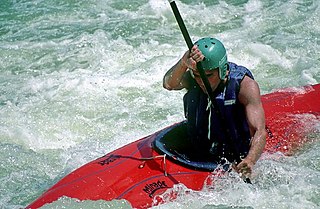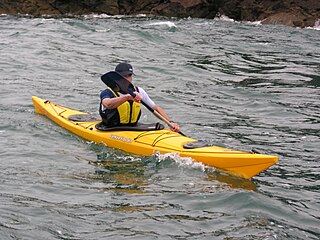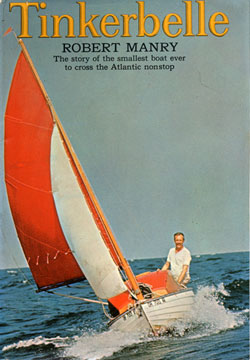Related Research Articles

A kayak is a small, narrow human-powered watercraft typically propelled by means of a long, double-bladed paddle. The word kayak originates from the Greenlandic word qajaq.

A sea kayak or touring kayak is a kayak developed for the sport of paddling on open waters of lakes, bays, and the ocean. Sea kayaks are seaworthy small boats with a covered deck and the ability to incorporate a spray deck. They trade off the manoeuvrability of whitewater kayaks for higher cruising speed, cargo capacity, ease of straight-line paddling, and comfort for long journeys.
Transatlantic crossings are passages of passengers and cargo across the Atlantic Ocean between Europe or Africa and the Americas. The majority of passenger traffic is across the North Atlantic between Western Europe and North America. Centuries after the dwindling of sporadic Viking trade with Markland, a regular and lasting transatlantic trade route was established in 1566 with the Spanish West Indies fleets, following the voyages of Christopher Columbus.
A folding kayak is a direct descendant of the original Inuit kayak made of animal skins stretched over frames made from wood and bones. A modern folder has a collapsible frame made of some combination of wood, aluminium and plastic, and a skin made of a tough fabric with a waterproof coating. Many have integral air chambers inside the hull, making them virtually unsinkable.

Tinkerbelle is a 13.5-foot (4.1 m) sailboat in which 47-year-old newspaperman Robert Manry, a copy editor at the Cleveland Plain Dealer, single-handedly crossed the Atlantic Ocean in 1965. At the time, it was the shortest but not the smallest boat to cross the Atlantic nonstop. He left Falmouth, Massachusetts on June 1 and arrived in Falmouth, Cornwall, England 78 days later, greeted by an armada of small boats and a huge crowd. Mayor Samuel A. Hooper of Falmouth officially welcomed him at the town's Custom House Quay. Robert Manry's wife Virginia and his children, Robin and Douglas, were also there, having been flown in from Willowick, Ohio.
Hannes Lindemann was a German doctor, navigator and sailor. He made two solo transatlantic crossings, one in a sailing dugout canoe made while working in Liberia and the second in a 17-foot Klepper Aerius II double folding kayak, modified to carry two masts and an outrigger. His book Alone at Sea documents the trips, which were totally unassisted. He was motivated to make the trips by an interest in how the human body and mind respond to survival at sea, a theme which the Kon-Tiki (1947) and Alain Bombard (1952) explored in earlier ocean voyages.

Ocean rowing is the sport of rowing across oceans. Some ocean rowing boats can hold as many as fourteen rowers; however, the most common ocean rowboats are designed for singles, doubles, and fours.

Robert Manry was a copy editor of the Cleveland Plain Dealer who in 1965 sailed from Falmouth, Massachusetts, to Falmouth, Cornwall, England, in a tiny 13.5-foot (4.1 m) sailboat named Tinkerbelle. Beginning on June 1, 1965, and ending on August 17, the voyage lasted 78 days.

Canoe diving and Kayak diving are recreational diving where the divers paddle to a diving site in a canoe or kayak carrying all their gear in or on the boat to the place they want to dive. Canoe or kayak diving gives the diver independence from dive boat operators, while allowing dives at sites which are too far to comfortably swim, but are sufficiently sheltered.

A tomol or tomolo (Chumash) or te'aat or ti'at (Tongva/Kizh) are plank-built boats, historically and currently in the Santa Barbara and Los Angeles area. They replaced or supplemented tule reed boats. The boats were between 10–30 feet (3.0–9.1 m) in length and 3–4 feet (0.91–1.22 m) in width. The Chumash refer to the tomol as the "House of the Sea" for their reliability. Double-bladed kayak-like paddles are used to propel the boat through the ocean. Some sources suggest the boats may have origins at Catalina Island and have been in use for thousands of years. Others suggest an origin on the Northern Channel Islands during the first millenium CE. The tomol has been described as "the single most technologically complex watercraft built in North America" and as being unique to "the New World."

Thirty years after the first person rowed solo across the Tasman Sea in 1977, Crossing the Ditch was the effort of Justin Jones and James Castrission, known as Cas and Jonesy to become the first to cross the sea and travel from Australia to New Zealand by sea kayak. Setting off from Forster, New South Wales on 13 November 2007 in their custom-designed kayak Lot 41, the two-man expedition succeeded after previous attempts, including the fatal journey of Andrew McAuley, had been unsuccessful. They arrived at Ngamotu Beach, in New Plymouth, New Zealand on 13 January 2008.
Hugo Vihlen is a single-handed sailor who set world records by crossing the Atlantic Ocean in two tiny sailboats in 1968 and 1993.

Sarah Dilys Outen is a British athlete and adventurer. She is also a motivational speaker in the UK and internationally. Outen was the first woman and the youngest person to row solo across the Indian Ocean and also the Pacific Ocean from Japan to Alaska. She completed a round-the-world journey, mostly under her own power, by rowing boat, bicycle and kayak, on 3 November 2015.
Jon Bowermaster is an oceans expert, journalist, author, filmmaker, adventurer and six-time grantee of the National Geographic Expeditions Council. One of the Society’s ‘Ocean Heroes,’ his first assignment for National Geographic Magazine was documenting a 3,741 mile crossing of Antarctica by dogsled.

The following outline is provided as an overview of canoeing and kayaking:

Aleksander Doba was a Polish kayaker known primarily for his long voyages crossing oceans. In 2010 and again in 2013 he kayaked across the Atlantic Ocean westward under his own power. The two voyages were the longest open-water kayak voyages ever made. He was named 2015 Adventurer of the Year by National Geographic. In 2017 he completed an eastward kayaking trip across the Atlantic. He died while climbing Kilimanjaro after reaching the mountain summit.
Isaac Mayo was a junior surfman in the United States Life-Saving Service, one of the agencies later amalgamated into the United States Coast Guard in 1915. On April 4, 1879, he led multiple and eventually successful efforts to rescue seamen stranded in an offshore wreck at the height of a violent storm.
L’Égaré II was the name of a raft used by a French crew in 1956 to cross the Atlantic Ocean. The expedition, led by Henri Beaudout, departed from Halifax, Nova Scotia, arriving 88 days later at Falmouth, England.
Chris Bertish is a South African surfer, stand-up paddleboarder, adventurer, and motivational speaker. In 2004 he gained recognition as the owner of 'Best Cribbar Barrel Vision Ever' after he pulled into a giant closeout at the infamous big wave spot in Cornwall. He won the Mavericks Big Wave Surf contest in 2009. In March 2017 he completed the first solo, unsupported stand-up paddle board (SUP) crossing of the Atlantic Ocean. He did it while supporting charitable organizations. He has also set other SUP world records. His efforts moved an obscure sport onto the forefront of many important media outlets.

Oliver "Olly" Hicks is a British ocean rower, kayaker, explorer and inspirational speaker. He holds three world records for adventure. He is best known for his solo ocean rows and extreme kayak voyages. He first made the headlines after his solo trans-Atlantic voyage in 2005 when he became the first and currently only person to row from America to England solo and the youngest person to row any ocean solo. Hicks has rowed and paddled over 7,000 miles on ocean expeditions since 2005. Over 6,000 miles and 220 days alone at sea.
References
- ↑ BBC news story Archived 2004-11-23 at the Wayback Machine
- ↑ Amazon book link
- ↑ Crew of Pink Lady "abandon ship", published by the Ocean Rowing Society on 2004-08-08; retrieved 2009-08-25.
- ↑ Rowers close to record are saved after boat is split by hurricane by Arifa Akbar, The Independent [UK]. Published 2004-08-09, retrieved 2009-08-25.
- ↑ Pete Bray awarded with Royal Humane Society Medal for Bravery. Ocean Rowing Society website (and also Royal Humane Society website), published June 2005.
- ↑ Bray's website (www.peterbrayadventurer.com)
- ↑ "Men's Journal | Health, Adventure, Gear, Style".
- ↑ "TK Watersports".
Please note that the other two crossings of the atlantic were undertaken in the Southern Ocean unlike Brays' who crossed the North Atlantic solo and unsupported—Lindemann actually used a sail --